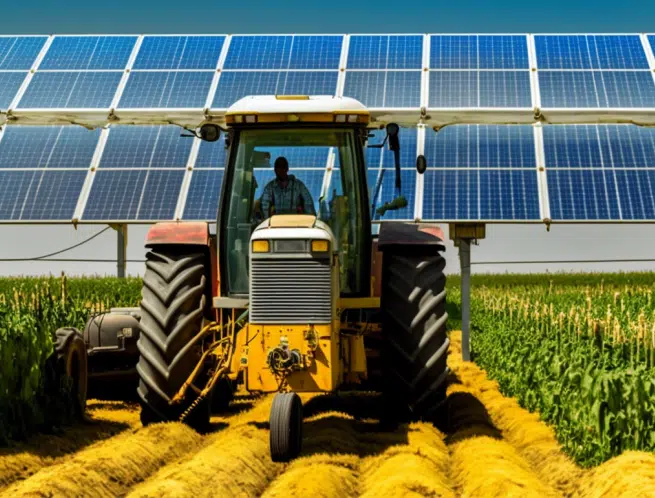Land use conflicts are stirring up a hornet’s nest of opposition to rural solar projects here in the US. The solar industry is facing similar conflicts elsewhere, including in the EU. Nevertheless, a new study focusing on the potential for solar development in four Central European nations indicates that the emerging science of agrivoltaics can improve both crop yields and income, offering a four-in-one solution that benefits farmers, food supplies, biodiversity, and energy resilience.
EU Nations Are Beginning To Propel Agrivoltaics Forward …
Agrivotaics refers to growing crops and pollinator habitats within a ground-mounted solar array. The practice began to take shape around 2018, when researchers began assessing the dual use of farmland for solar power and agriculture.
At first glance, it may seem like a lose-lose proposition. The solar panels leave less room for crops, and the crops leave less room for panels, leaving the farmer with two less-than-optimal operations on the same land.
As a science-based practice, though, agrivoltaics has quickly begun to bear positive results. Some crops do better in partial shade, and the high performing solar modules of today can generate the same — or more — electricity than earlier technologies while taking up less space. With research and data in hand, solar developers are also working with farmers to establish new strategies that maximize both benefits (see more agri-PV background here).
The evidence is clear enough to prompt new public policies that support agrivoltaic development. The new agrivoltaic study, from the data-focused think tank Ember, provides the example of Germany. The country established formal, technical guidelines for agrivoltaic systems in 2021, followed by legislative amendments providing an economic framework to stimulate adoption.
“According to the recent survey, more than 70 % of farmers in Germany are now willing to implement the technology,” the study authors note.
… But Central Europe Is Lagging Behind
Published under the title Empowering farmers in Central Europe: the case for agri-PV, the new study compares Germany and other EU nations to four Central European nations that have been lagging behind the agrivoltaic pack, missing out on important benefits covering farmer income, food supply, and decarbonization.*
Empowering farmers presents a large body of evidence indicating that the strategic placement of agrivoltaic arrays increases the yield of shade-tolerant crops, rather than lowering them. “Several years of intensive research across Europe and beyond has shown that agri-PV can increase crop yields by up to 16% in the case of fruits or berries,” the authors observe.
Wheat and other sun-loving field crops require more space between the rows of solar panels to minimize shade and allow passage for harvesters, plows, and other machinery. Still, Ember describes how a wheatfield with solar panels can be more profitable than one without.
Although the solar array reduces the amount of space available for cultivation, the loss can be kept below 20% by new bifacial solar technology, which takes up less space. The 20% threshold is important because it provides enough room for income from the solar array to make up the difference, and then some.
“A case study shows that an annual profit of €,1268 (about $1,405 USD) per hectare is possible from combined electricity and wheat sales. This contrasts with traditional wheat production (without agri-PV) that is estimated to be generating net losses in 2024,” the authors write, underscoring the falling price of wheat in the region.
Despite the significant advantage of generating profit instead of loss, Ember notes that Czechia is the only Central European nation to adopt legislation supporting agrivoltaics.
“Czechia’s recent introduction of agri-PV legislation started a debate on the topic, but the potential of agri-PV remains unrecognised in Central Europe, and countries like Hungary, Poland and Slovakia are still lacking regulatory frameworks,” Ember concludes.
Agrivoltaics And Energy Independence
Aside from the potential to catch the attention of agricultural policy makers, Empowering farmers is also deeply relevant to the ongoing energy transition in the EU, with Russia’s unprovoked invasion of Ukraine adding urgent national security fuel to the climate crisis fire.
As described by the study, a strong agrivoltaic profile among the four Central European countries would add a total of 180 gigawatts of locally produced renewable energy to the decarbonization efforts of the EU, with a consequent impact on the energy independence of the EU as well.
The total of 180 gigawatts would come out to 191 terrawatt-hours of clean power generation per year, enough to provide for 68% of the electricity demand among Czechia, Hungary, Poland, and Slovakia.
“Using just 9% of that generation could cover the entire electricity needs of farming and food processing,” the authors note, referring to those four countries. By way of comparison, the EU currently generates 73 terrawatt-hours of renewable electricity.
“Consequently, agri-PV would significantly contribute to the 2030 solar capacity targets set in the revised National Energy and Climate Plans. These equate to 60 GW for the four countries combined, compared to the current 25 GW of total installed solar capacity,” the authors point out.
The Land Use Efficiency Factor
Land use issues also weigh heavily on the solar energy industry in Europe, as they do here in the US. To address objections related to land use, Empowering farmers deploys a measurement called land use efficiency.
The calculation factors in the electricity generated by conventional solar arrays compared to agrivoltaic arrays, and the crop yield from a full-sun field compared to a partially shaded field.
“Depending on crop type, the results can reach 170-180% for berries, fruits and fruity vegetables and 110-130% for root vegetables, cereals and forages,” the authors conclude, which seems to settle the case.
“Even the least shade tolerant crop, maize, reaches 104% land use efficiency, showing that agri-PV will be more productive than the traditional approach of separating ground-mounted solar and farming,” they emphasize.
As for saving the rural landscape from industrialization, the authors point out the obvious: the agrivoltaics strategy enables farming to continue on the same land, preserving it from urban sprawl, fulfillment centers, and other non-agricultural purposes. They also take note of the compatibility with regenerative farming practices that promote biodiversity, water conservation, and soil health.
Here in the US, agrivoltaics is helping to break down partisan political walls as well, indicating that farmers can form powerful alliances with the solar industry to accelerate the energy transition while on a firm financial footing.

